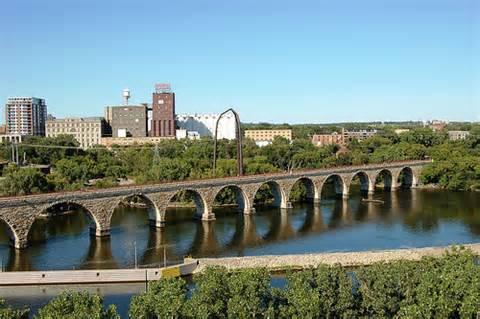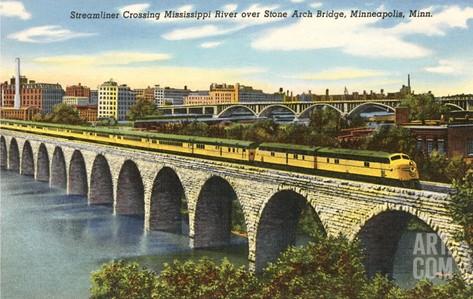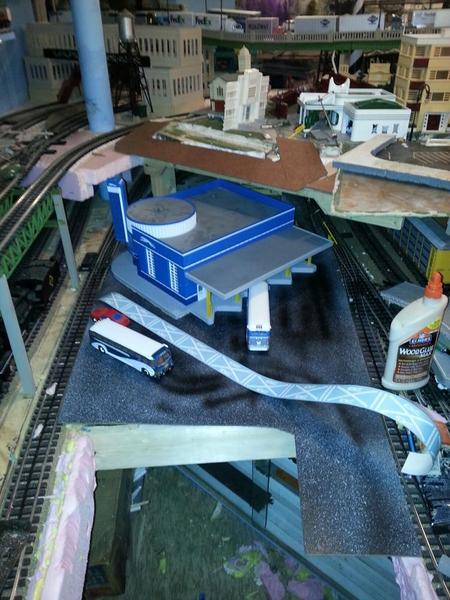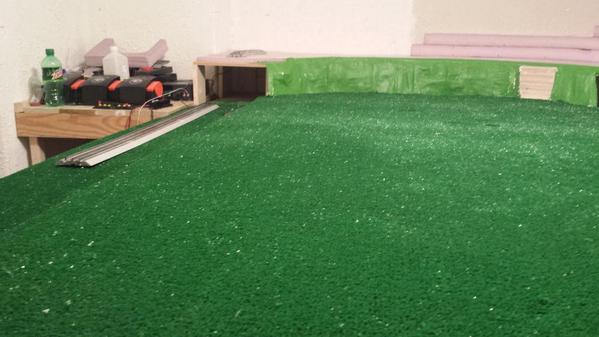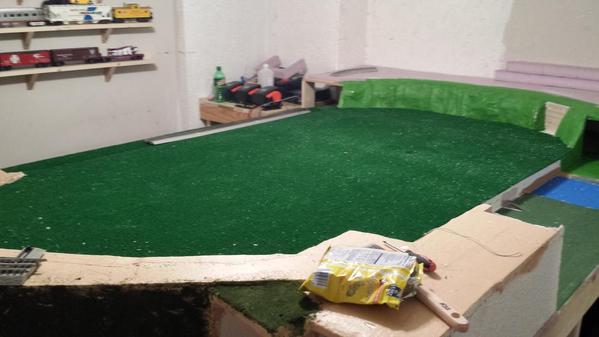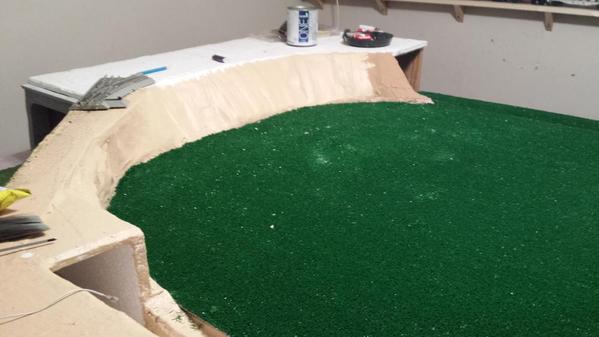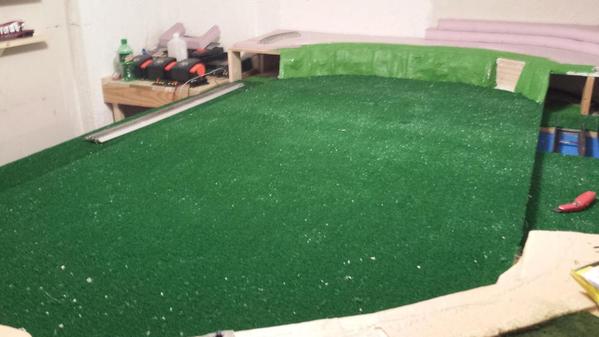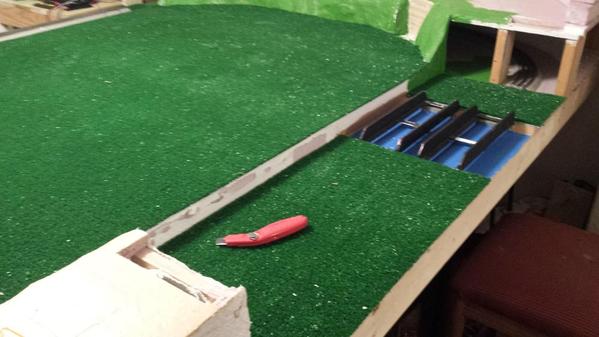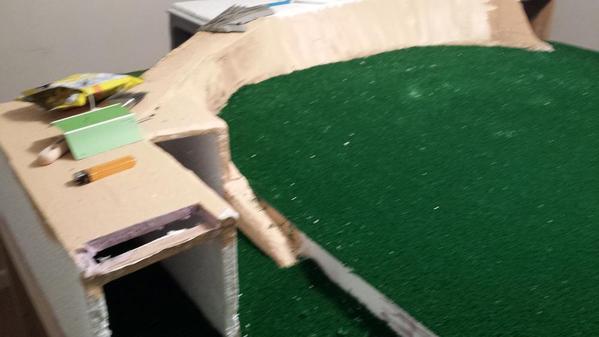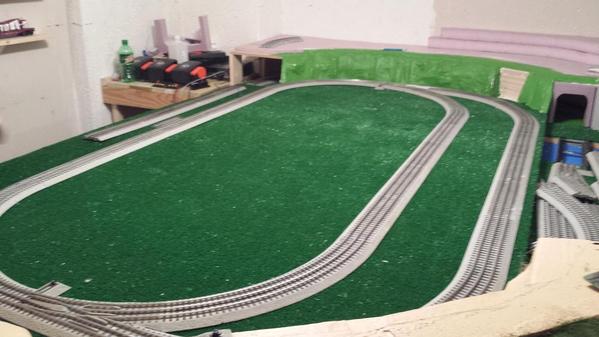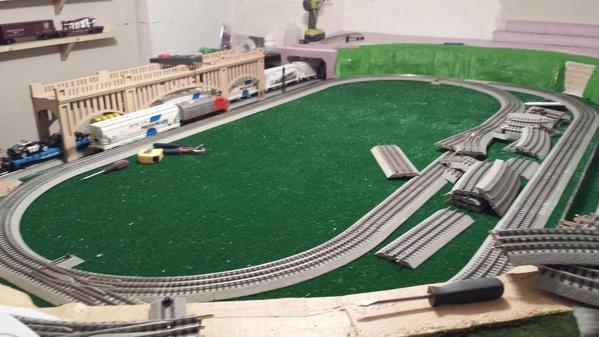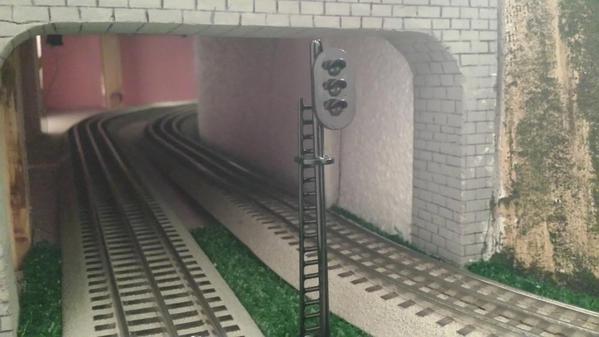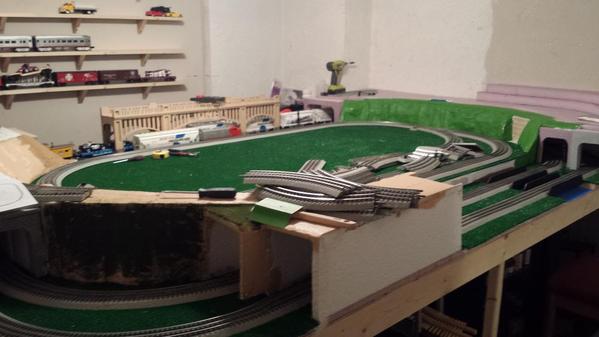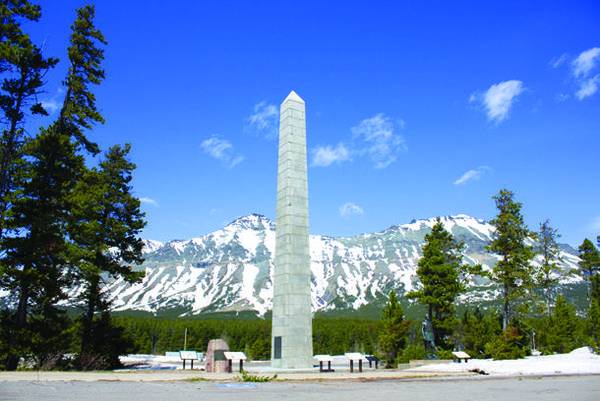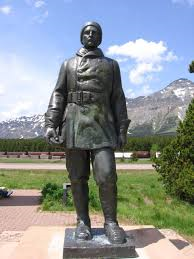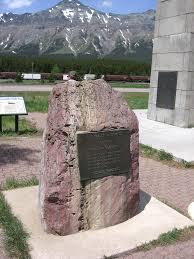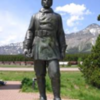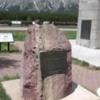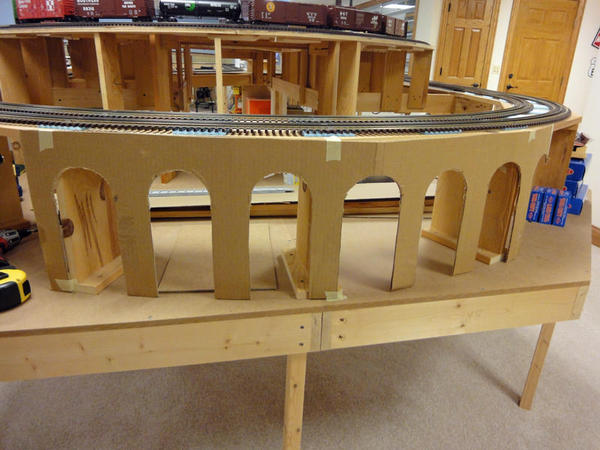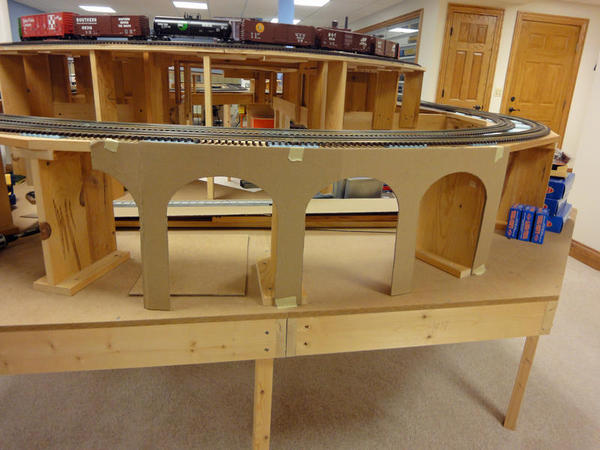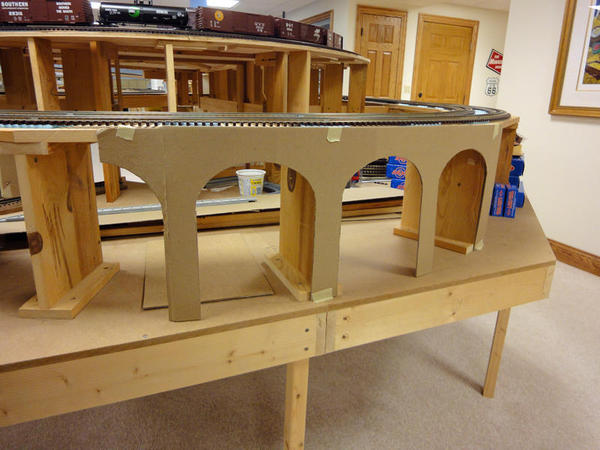For the first time in 3 weeks Patrick came over, and we actually did some construction.
The new hidden yard is now ready for track!
Just like the old hidden yard, the new hidden yard is situated on a reverse loop.
Trains will travel past the yard, around the loop, then into one of the 7 tracks.
Next week is going to be crazy, Jon (Mill City) on Tuesday, Matt on Wednesday, and Patrick on Thursday. The goal is to get the hidden yard laid and powered, so the temporary cutoff can be removed once and for all. Shooting for the end of April.
Elliot, I see you and Patrick got a lot done. I'm afraid to ask where all the "STUFF" that was in that corner ended-up. Looks great. See-ya Tuesday.
It went to a number of different places. Unfortunately, not enough of it went in the trash. Don't worry there's plenty left.![]()
I am starting the process of working on my bridge that will be on the curve coming out of my passenger terminal. I am thinking that I want a curved stone arch bridge that is loosely based on the one in Minneapolis. The first step is experimenting with cardboard mockups to determine the sizes and shapes of the arches. Here is a picture of the first attempt.
Attachments
Very good Start, Art. Having looked at the real thing you are duplicating, you sure are on the right "track".
Thanks, Brian. It has been pointed out to me that the real bridge has more elliptical arches, but I'm not sure that that is important. Here are a couple pictures of the real bridge that is in Minneapolis. It's not important to me to make an exact copy of this bridge, but I want to follow it loosely. I decided to also post these on the weekend photo fun.
Art
Attachments
Art, this is a model of the Stone Arch Bridge at the Twin Cities Model Railroad Museum. I hand painted every stone 25 years ago. This model doesn't include every arch. I think the real one has 22. But the arches it does have are the correct proportion, which give it the look of the real thing.
As long as you are still working with cardboard, you might want to try fewer, wider arches.
Attachments
Elliot - That is a beautiful model! I would love to learn more about how it was constructed. I am also interested in how the water was done too. Is it still there? Thanks for sharing the picture.
Art
I didn't build the bridge. It was done by 3 generations of the same family. It's made from basswood strips that were textured, then applied over a superstructure. Around the arches, individual pieces were hand fitted. The club is open to the public.
You should get a group of the Chicago guys and come up for a visit. Maybe even take the train.![]()
Art....your mock-up looks good. I would be very interested in your construction ideas. I am considering building a curved arch as well and was considering Masonite board.
Rick
Art
if you want elliptical arches then you would need to cut one from wood or masonite to use as a template for the others. Once cut, dont worry about exactness if you intend to cover the arch with stone because you can create a "negative" of the curved- elliptical shape to use as an under arch form to help set the stone for each arch.
Art....
The arches that support my city are made from pink insulation foam sheets. It was as simple as drawing out the design directly on the foam and then cutting it. From there you can paint and weather to your taste and then use a soft lead pencil to draw a block or brick pattern. The pencil creates the mortar joints and a relief to the surface. The foam can be bent into graceful curves, etc..... The picture below, even though it is not in a bridge form as you intend, shows the finished arches for the city....
Alan
Attachments
Alan
those spans supported by the Lionel supports are cute! Please replace at your next opportunity or I will send the bridge police over to your house to remove!
underground bus station. When enlarging the town to accept the Woodland Scenics buildings I added an under town bus station (MTH Greyhound) that connects to the train station and has a ramp road leading up to the town ( not yet connected).
The RR crossing "decals" are from Red Lion ($5.00).
Attachments
Art
See how Alan has done his elliptical arch. A simple but elegant concrete with just arch stones around the opening arch then using stone for the supports going down.
Rick - I am thinking that I will make the basic shape out of 1/8" Masonite. It is bendable enough yet will have a lot of strength when it is curved. I most likely will then cover it with thin foam and then use a pencil to "carve" the stones on it. Please share your ideas and progress so we can all learn from it.
Alan - Thanks for your input. Your a tough act to follow, but I appreciate your suggestions.
Alan - I am going to have to try an elliptical pattern and see how it looks. I know it looks great on the real bridge in Minneapolis, but I also like the look of the first cardboard template too. Another decision is whether to lower the entire bridge? It is currently designed to be 12" high. A taller bridge would be more dramatic, but is it worth the trouble to redo all the bench work in this area? I'm thinking not, but am interested in your opinions.
Art
Elliott:
That is a fabulous arched bridge. You sure have painting skills.
Alan...thanks! Actually, the stone supports are Woodland Scenics HO retaining walls. They are plaster castings that I stained with....are you ready?.....ground cloves from my wife's pantry!! Yep, took the stark white castings and put them in a bowl of water, added the powdered cloves and heated the mixture up in the microwave. Let them sit for about 10 minutes or so and the result turned out great. ( I remembered from past experience that cloves stain clothing quite well..LOL!!)
Alan
Alan
The stone support supporting the lift bridge are great. It's the other Lionel elevating supports sitting atop those concrete bridge bases aah not so much! If you are going to use the Lionel elevated supports then cut off the base so they dont overhang the bridge support and add your own base plates then sit those on the bridge supports.
However, employing the many concrete plastic bridge bases, we all have that come with each MTH and Lionel Bridge, in any way, is a fabulous testament to "waste not want not."
Alan...OH..OK, I thought you were referring to the supports on the arches. Yes, I have to agree with you. I was trying to come up with something different for the approach bridge supports going to the lift bridge and came up with the idea of using something I already had. I don't like them all that much either and have for quite some time thought about changing them. As a matter of fact, I have some nice MTH stone supports that I am working on right now so keep your eyes posted, a change may be in the near future!!
Alan
Alan
Definitely. You hired a mason for most of the work in that area so give him/her some extra work doing the supports.
Elliott:
That is a fabulous arched bridge. You sure have painting skills.
Thank you, but I'm afraid I may have lost them. It took patience and a steady hand back then.
well I did a lot today I think. while at a home store today they had a remeinant of indoor out door carpet so I bought it and brought it home pulled off all the track on the whole layout and began putting it down and cutting it around mountains and and then began reinstalling the track. installed 3 signals screwed down 2 loops of track here's the results.
Attachments
This is also a real life history lesson existing today on the top of Marias Pass which is located on the southern boundary of Glacier National Park.
03-23-2014 Connie and I worked on our models of three real life ...objects that are situated in real life in Marias Pass at the summit in a place named: Marias Pass Memorial Square. The three real life objects are:
The Theodore Roosevelt Memorial monument ...... constructed in 1931 honors the president who made forest conservation a national policy. It also marks the 25th anniversary of the U.S. Department of Agriculture, Forest Service. The monument was originally to have been a granite arch spanning the highway. Instead, this obelisk was built. The monument is a tapering 60-foot tall obelisk which resembles the Washington Monument. Its concrete core originally extended 19 feet underground. The seven-inch-thick granite slabs covering the monument were quarried from a source near Helena, the state's capital.
John F. Stevens statue. He was a civil engineer for the Great Northern Railroad. He was charged with finding a suitable rail route across the Continental Divide. In December of 1889, Stevens located and recorded the pass which had been used by area Native Americans for many centuries. By 1893, the Great Northern was running trains over Marias Pass. This route provided the lowest pass (at 5,216 feet above sea level) and the shortest link between the headwaters of the Mississippi River and the Pacific Coast.
William H. "Slippery Bill" Morrison, (ROCK with PLAQUE) claimed "squatter's rights" to the land at Marias Pass. Through diplomatic negotiations by the Columbia Falls Chamber of Commerce and others (including Supervisor Hornby of the Flathead National Forest), Morrison agreed to donate his rights to this land for building a monument to Theodore Roosevelt. Morrison stipulated that no concessions, "hamburger stands" as he referred to them, would be built on any of this property during his lifetime.See More
Attachments
This is also a real life history lesson existing today on the top of Marias Pass which is located on the southern boundary of Glacier National Park.
03-23-2014 Connie and I worked on our models of three real life ...objects that are situated in real life in Marias Pass at the summit in a place named: Marias Pass Memorial Square. The three real life objects are:
The Theodore Roosevelt Memorial monument ...... constructed in 1931 honors the president who made forest conservation a national policy. It also marks the 25th anniversary of the U.S. Department of Agriculture, Forest Service. The monument was originally to have been a granite arch spanning the highway. Instead, this obelisk was built. The monument is a tapering 60-foot tall obelisk which resembles the Washington Monument. Its concrete core originally extended 19 feet underground. The seven-inch-thick granite slabs covering the monument were quarried from a source near Helena, the state's capital.
John F. Stevens statue. He was a civil engineer for the Great Northern Railroad. He was charged with finding a suitable rail route across the Continental Divide. In December of 1889, Stevens located and recorded the pass which had been used by area Native Americans for many centuries. By 1893, the Great Northern was running trains over Marias Pass. This route provided the lowest pass (at 5,216 feet above sea level) and the shortest link between the headwaters of the Mississippi River and the Pacific Coast.
William H. "Slippery Bill" Morrison, (ROCK with PLAQUE) claimed "squatter's rights" to the land at Marias Pass. Through diplomatic negotiations by the Columbia Falls Chamber of Commerce and others (including Supervisor Hornby of the Flathead National Forest), Morrison agreed to donate his rights to this land for building a monument to Theodore Roosevelt. Morrison stipulated that no concessions, "hamburger stands" as he referred to them, would be built on any of this property during his lifetime.See More
John
Cool update and nice modeling.
The rest of you, let's not re-post the photos every time we comment.
jackson
Jhainer, that's impressive. How is the I/O carpet to work with?
honestly it was easy. removed all the track laid it down cut to fit . put track back over it. the thing I have found to be a nice feature of it has been the sound reduction in running trains on fastrack. now when I run I can hear the clickity clack of the trucks on the track joints. I did not glue it down the track holds it in place once screwed down. I did leave a small over hang so when I do my facia I can trim to it . another thing I have done this weekend was ran wiring for the signal lights got them somewhat working. and ran longer wire for fastrack switches the longer wire is standard phone line has the same color combo as the fastrack switch wire. I did order switch controllers so I should be wiring that up in the near future. the only thing I don't know how to do yet but have ideas is how to do roads for a city street. do I just place it over the carpet or cut out that area. I would also like to ballast the track but not sure how that would work with the carpet either. here's a video of the train running last night with the lights. they act alittle funny when doing a isolated block 3 in my case do you leave a section that isn't isolated between each block I didn't and I am thinking that might be why the lights are acting funny.
Working on my stone arch bridge and trying to decide on the shape of the arches. A friend made me some elliptical patterns and I cut what I felt was the most promising one out of cardboard to compare it to the first trial. The first one was just using a 4" hole saw for the top of the arch.
Which do you think looks better? What should I do differently?
Art
Attachments
Oh, and while I was at it I managed to get my Milwaukee Road F-3's running again.
When I was trying to run a few trains to show some non-train friends the layout last Saturday night and talking at the same time, I had a "phantom" derailment. My F-3 "picked a switch" that it had run over countless times before with no problem. We all know the "phantom" and "Murphy" show up to help when we have company. Had a bad short and after restoring the power, the engine wouldn't run.
After playing with it today, I discovered that the "phantom" somehow added another engine to my handheld with everything correct except the assigned engine number. After deleting the added engine, everything is back to normal. At least until I have company again.
Art
I like the second or wider version.
Chugman,
I agree with Brian, number 2 would be my choice also.
Joe B.
Just a personal opinion, Art, but I think you've nailed it with the elliptical arches, they just seem more graceful. Especially with the incline, they just kinda cascade from one to the next. It's all just personal taste, though - I could see someone saying the first ones looked more solid, like a Roman aquaduct. I think a lot of the finished look is going to depend on the details like the size of the stones. I don't see it turning out bad whatever you do, it's a really nice feature.
I wired 4 passenger yard tracks today. I have a bunch of extra 110 light switches left over from the basement work. I have ben using them as track switches to turn power on/off on the yards tracks.
Today I used X10 pushbutton switches. The track would have power when measured with a volt meter. As soon as I would put a lighted car on the track, the power would die. I thought I wired something wrong, but double checked and all was right. I swapped out the X10 switches for traditional wall switches all worked fine.
So I guess the X10 has something in them that the track power does not like.
Ron
Attachments
Working on my stone arch bridge and trying to decide on the shape of the arches. A friend made me some elliptical patterns and I cut what I felt was the most promising one out of cardboard to compare it to the first trial. The first one was just using a 4" hole saw for the top of the arch.
Which do you think looks better? What should I do differently?
Art
Art,
I agree with everyone else, the second one looks much better, and I think much more prototypical.
Art I have to agree with the Rest of the Guys. I would go with the second one. It looks much better then the first photo.
Completed a depot repaint and re-detail I've been wanting to do for a very long time. You can even read the writing on the bulletin chalkboard if you break out a magnifying glass...
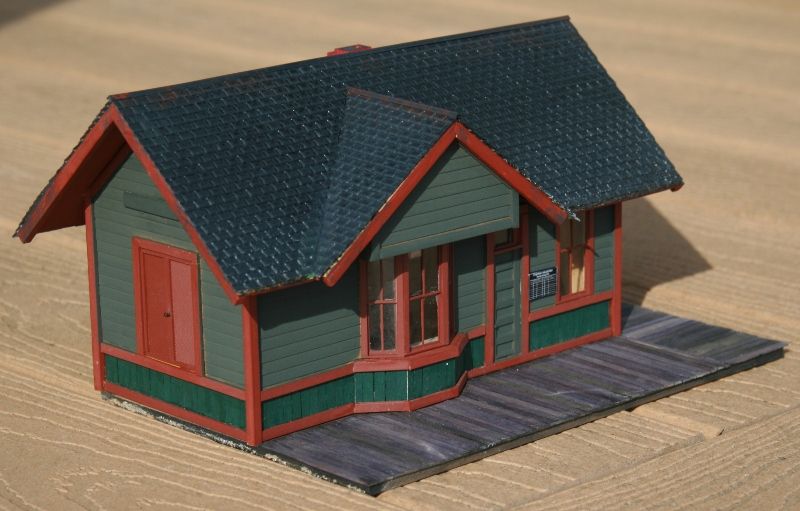
Tough call, Art...both look really good, but I will go against the popular vote and choose the first one. I think I like the fact it will contain more stonework with the narrower arches. You can't go wrong with either design, however.
Rick
Not a lot of progress today, got most of my drops, dropped, lol. Track is back together. Just a couple loose ends to finish putting through the deck and it's on too wiring everything up and getting the second half powered ![]()






